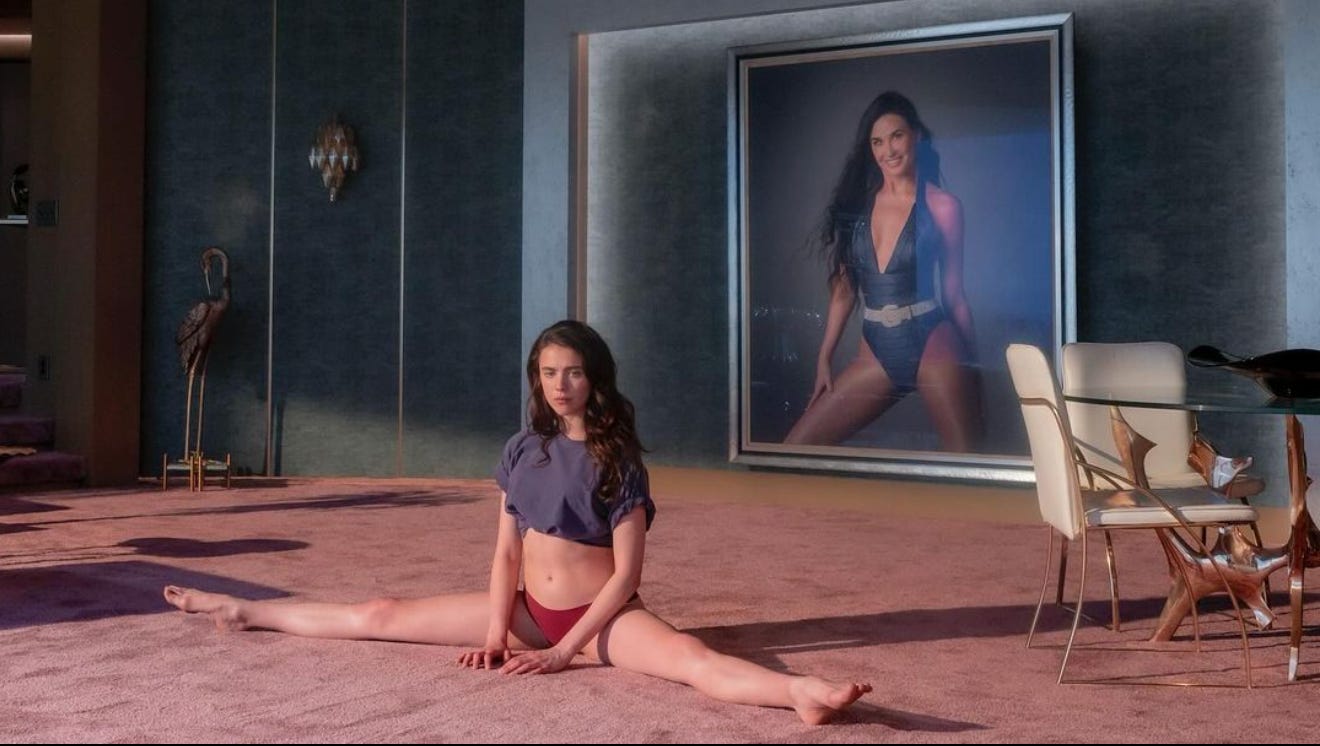The Substance and hate-eating chicken
On Demi Moore’s new horror movie and the New York film festival.
I trust by now a portion of you have watched The Substance? Critiques of Coralie Fargeat’s new movie have been rippling since its divisive Cannes premiere earlier this year, where it inspired many a walk out. The film’s lack of subtlety for some is an issue and while others a boon. For me it was mostly the latter. The key to your enjoyment is to approach it as a tour-de-force of midnight viewing and not dwell too heavily on the single-mindedness of its conceit. The substance is after all an easy Ozempic stand in, which I asked Fargeat about when I interviewed her for Vogue. She also talked about bright yellow pea coat Demi wears. More on the film below, with references to binge-eating.
In NICKEL BOYS, RaMell Ross *does* something with Colson Whitehead’s novel, setting an inconceivably high bar for all page-to-screen adaptions to come and cementing his auteur status. Disruptively lyrical.
Mike Leigh is so back with HARD TRUTHS. Adult drama with flawed people, tricky empathy, no preaching. All the best parts of a play, outfitted with devastation and outrage. I wrung my hands white with tension. The best film of the year so far.
PAVEMENTS is an audacious hybridization tipping back and forth between sly and sincere. Alex Ross Perry gives the World’s Greatest and Most Important Band genre-defying treatment in this three-headed film. You’ll understand when you see it. Stephen, Steve, Scott, and Mark & Bob 4ever.
I knew I would love ON BECOMING A GUINEA FOWL the second I heard the Lijadu Sisters and saw the protagonist costumed as a Supa Dupa Fly Missy Elliott. The film from Welsh-Zambian director Rungano Nyoni brings subtle comedy to traumatic material and transcends cultural boundaries. I felt like I just visited my family in Korea.
My strongest films of the festival were the shortest:
Leo Carax’s 45 minute IT’S NOT ME was a playfully philosophical palate cleanser indebted to Godard.
Granting powers of speech to African works of art, Mati Diop’s 67 minute documentary DAHOMEY about the repatriation Beninese artifacts is a deceptively tidy achievement that decolonizes art in more ways than one.
Carlo De Los Santos Arias similarly gives voice to silent in PEPE. In this case a family of hippos once owned by Pablo Escobar. Mixing aspect ratios, textures, and storytelling modes, this anti nature-doc felt a bit unwieldy in its attempt to highlight and make cohesive the lasting impacts of colonialism. It also reminded me of last year’s EUREKA, now playing, which I found more harmonious.
Hypnotizingly meta, THE BALLAD of SUZANNE CESAIRE is a formally and politically radical inquiry into the life of the Surrealist writer. Poetically fragmented, it grapples with the elusiveness of portraiture by withholding traditional information dumps and flooding us instead with bits of voice over, staged reenactments, and tons of images of the natural world rendered in lushly pigmented 16mm.
Yashaddai Owens also attacks the biopic from an oblique angle. JIMMY is a freewheeling impression of James Baldwin that captures his vulnerable essence as a youth.
I must recant any and all negative things I’ve said about dogs having watched THE FRIEND, in which Naomi Watts must contend with her dead friend’s Great Dane. The New Yorker had a lengthy profile of the animal trainer and preparing the canine for the role.
One of the most pleasurable things you can watch at the festival is the restoration of Frederick Wiseman’s MODEL, which gives the new york fashion world the observational fly-on-the-wall treatment.
Ask and you shall receive. I’ve started working on a fall/winter movie guide with notable releases! Still a WIP.
THE SUBSTANCE
dir. Coralie Fargeat
Something’s off about the Los Angeles of The Substance. The Overlook Hotel inspired carpeting and dramatically empty apartment hints at something askance in the world of this movie, which isn’t just an unwaveringly deranged account of the perils of today’s unattainable beauty standards but a cautionary moral tale about self-mythologizing and the lethality of the gaze.
Keep reading with a 7-day free trial
Subscribe to MOVIEPUDDING to keep reading this post and get 7 days of free access to the full post archives.







